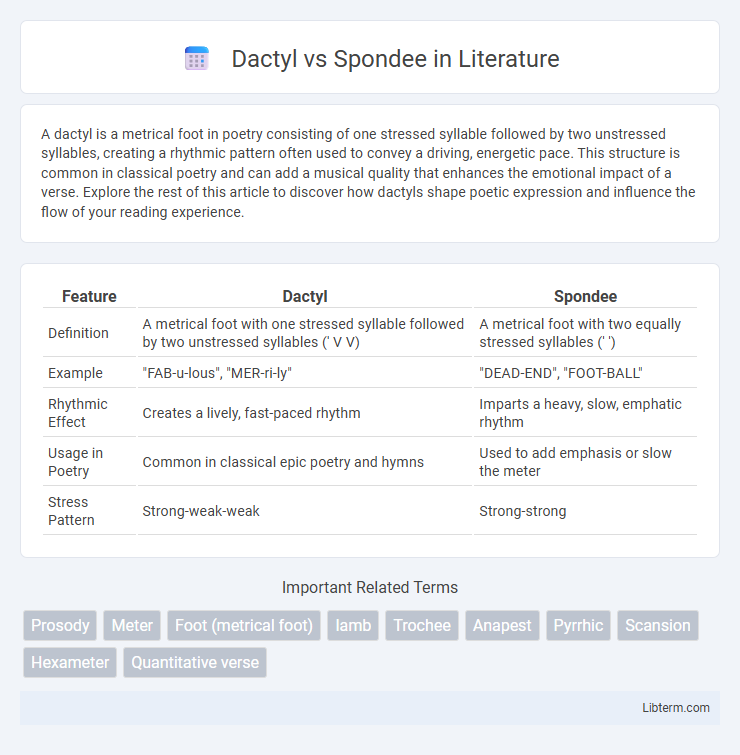A dactyl is a metrical foot in poetry consisting of one stressed syllable followed by two unstressed syllables, creating a rhythmic pattern often used to convey a driving, energetic pace. This structure is common in classical poetry and can add a musical quality that enhances the emotional impact of a verse. Explore the rest of this article to discover how dactyls shape poetic expression and influence the flow of your reading experience.
Table of Comparison
| Feature | Dactyl | Spondee |
|---|---|---|
| Definition | A metrical foot with one stressed syllable followed by two unstressed syllables (' V V) | A metrical foot with two equally stressed syllables (' ') |
| Example | "FAB-u-lous", "MER-ri-ly" | "DEAD-END", "FOOT-BALL" |
| Rhythmic Effect | Creates a lively, fast-paced rhythm | Imparts a heavy, slow, emphatic rhythm |
| Usage in Poetry | Common in classical epic poetry and hymns | Used to add emphasis or slow the meter |
| Stress Pattern | Strong-weak-weak | Strong-strong |
Introduction to Dactyl and Spondee
Dactyl and spondee are metrical feet used in poetry to establish rhythm and pacing, with dactyl consisting of one stressed syllable followed by two unstressed syllables (' V V) and spondee comprising two equally stressed syllables (' '). The dactyl creates a falling rhythm often used to convey lively or rapid movement, while the spondee slows the pace, emphasizing weight and seriousness in verse. Understanding the distinction between dactyl and spondee is essential for analyzing classical and modern poetic meter, including works by Homer, Longfellow, and other influential poets.
Defining Dactyl: Structure and Examples
A dactyl is a metrical foot in poetry consisting of one stressed syllable followed by two unstressed syllables, exemplified in words like "elephant" and "wonderful." This rhythm creates a falling pattern that often lends a lively and energetic pace to verses. Dactylic meter is commonly used in classical and English poetry to produce a melodic and flowing effect.
Understanding Spondee: Structure and Usage
Spondee is a metrical foot in poetry consisting of two stressed syllables (' '), creating a slow and emphatic rhythm that contrasts with the quicker pace of a dactyl, which features one stressed syllable followed by two unstressed syllables (' V V). The structure of a spondee provides weight and emphasis, often used to highlight important words or to slow down the tempo of a line, enhancing the dramatic effect. In classical and modern poetry, spondees frequently appear in combination with other metrical feet, serving as strategic pauses or accents to underscore meaning and mood.
Historical Origins in Classical Poetry
The dactyl and spondee are metrical feet rooted in ancient Greek and Latin poetry, integral to classical versification. The dactyl, comprising one long syllable followed by two short syllables, was famously employed in epic poetry such as Homer's "Iliad" and Virgil's "Aeneid" to produce a rhythmic, flowing cadence. The spondee, consisting of two equally long syllables, often served to slow the meter or add emphasis in classical hexameter lines, providing contrast to the more rapid dactylic pattern.
Dactyl vs Spondee: Key Differences
Dactyl and spondee are metrical feet used in poetry, with dactyl consisting of one stressed syllable followed by two unstressed syllables (' _ _), while spondee comprises two equally stressed syllables (' '). The key difference lies in their rhythmic pattern, where dactyl creates a falling rhythm, and spondee produces a heavy, slow beat that emphasizes words. Understanding these distinctions helps poets control pace and mood within verse.
Functions in English and Classical Verse
Dactyl and spondee serve distinct metrical functions in English and classical verse, shaping rhythm and emphasis within lines. A dactyl, characterized by one stressed syllable followed by two unstressed syllables (' - V V), often produces a flowing, upbeat rhythm that propels poetry forward, frequently used in elegiac and hexameter meters in classical Greek and Latin poetry. In contrast, a spondee, consisting of two equally stressed syllables (' '), introduces a weighty, deliberate pace, emphasizing key words or phrases to create dramatic tension or solemnity in both English prosody and classical verse forms like the dactylic hexameter where spondees can replace dactyls to vary rhythm.
Impact on Rhythm and Meter
Dactyl, a metrical foot with one stressed syllable followed by two unstressed syllables, creates a flowing and energetic rhythm often used in classical poetry like Homeric epics. Spondee, consisting of two equally stressed syllables, introduces emphasis and slows the pace, providing contrast and weight within a verse. The interplay between dactyls and spondees significantly shapes the poem's rhythm and meter, balancing speed and gravity to enhance emotional impact.
Famous Poems Featuring Dactyls and Spondees
Famous poems featuring dactyls, such as Henry Wadsworth Longfellow's "Evangeline," showcase the pattern of one stressed syllable followed by two unstressed, creating a flowing, lyrical rhythm. In contrast, spondees--consisting of two equally stressed syllables--appear prominently in classical poetry like Homer's epics, where they emphasize heroic action and dramatic intensity. Understanding the use of dactyls and spondees in poetry enhances appreciation for rhythmic variation and emotional impact in literary works.
Practical Tips for Identifying and Using Each Foot
Dactyl and spondee are metrical feet used in poetry, with dactyl consisting of one stressed syllable followed by two unstressed syllables, and spondee comprising two equally stressed syllables. To identify a dactyl, listen for the rhythmic pattern of a strong syllable followed by two lighter ones, often found in words like "carefully" or "beautiful." Use a dactyl to create a flowing, musical effect, while spondees, as in "heartbreak" or "dead-end," provide emphasis and slow the pace, making lines more dramatic and forceful.
Conclusion: Enhancing Poetry with Metrical Variety
Dactyl and spondee offer contrasting rhythmic patterns that enrich poetic meter by blending dainty, flowing beats with strong, deliberate stresses. Incorporating dactyls injects a lively, bouncing tempo, while spondees emphasize solemnity and weight, creating emotional depth and dynamic pacing. Skillful combination of these metrical feet enhances reader engagement, providing texture and complexity to poetic compositions.
Dactyl Infographic

 libterm.com
libterm.com